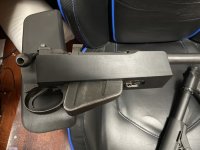Blastattack
CGN Ultra frequent flyer
- Location
- Winnipeg MB
I am designing and intend to make a stock to fit an Enfield No4, but I am having trouble understanding the mechanics of how the forestock actually mates with the receiver. I am familiar with the concept of the draws, the small angled protrusion where the magazine release and sear pivots are, and that it pushes the stock back towards the wrist. What I do not understand is the forestock is not supposed to touch the wrist, but what is preventing that from occurring? Is the front screw boss also bearing on the wood, creating tension between itself and the draws and preventing the stock from moving backward?
The intended design is a sort of chassis system where the draws can be adjusted, either up and down or fore and aft to account for differences between rifles. Is this sufficient, or do I need to make an adjustable "socket" for the receiver screw boss as well? How much clearance should there be between the rear of the forestock and the wrist socket?
The main chassis will be machined from aluminum and I intend to make the draws either from hardened steel or aluminum. What's better? Does it really matter, seeing as the originals are wood?
I've already designed a rear stock adapter, because why not go full out?
The intended design is a sort of chassis system where the draws can be adjusted, either up and down or fore and aft to account for differences between rifles. Is this sufficient, or do I need to make an adjustable "socket" for the receiver screw boss as well? How much clearance should there be between the rear of the forestock and the wrist socket?
The main chassis will be machined from aluminum and I intend to make the draws either from hardened steel or aluminum. What's better? Does it really matter, seeing as the originals are wood?
I've already designed a rear stock adapter, because why not go full out?








































































